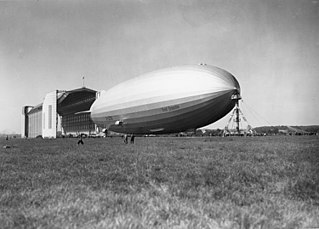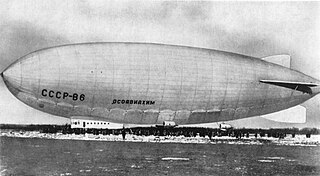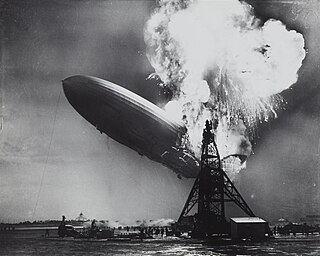Related Research Articles

A hot air balloon is a lighter-than-air aircraft consisting of a bag, called an envelope, which contains heated air. Suspended beneath is a gondola or wicker basket, which carries passengers and a source of heat, in most cases an open flame caused by burning liquid propane. The heated air inside the envelope makes it buoyant, since it has a lower density than the colder air outside the envelope. As with all aircraft, hot air balloons cannot fly beyond the atmosphere. The envelope does not have to be sealed at the bottom, since the air inside the envelope is at about the same pressure as the surrounding air. In modern sport balloons the envelope is generally made from nylon fabric, and the inlet of the balloon is made from a fire-resistant material such as Nomex. Modern balloons have been made in many shapes, such as rocket ships and the shapes of various commercial products, though the traditional shape is used for most non-commercial and many commercial applications.

LZ 129 Hindenburg was a German commercial passenger-carrying rigid airship, the lead ship of her class, the longest class of flying machine and the largest airship by envelope volume. She was designed and built by the Zeppelin Company on the shores of Lake Constance in Friedrichshafen, Germany, and was operated by the German Zeppelin Airline Company. She was named after Field Marshal Paul von Hindenburg, who was President of Germany from 1925 until his death in 1934.

An airship is a type of aerostat or lighter-than-air aircraft that can navigate through the air flying under its own power. Aerostats use buoyancy from a lifting gas that is less dense than the surrounding air to achieve the lift needed to stay airborne.

LZ 127 Graf Zeppelin was a German passenger-carrying hydrogen-filled rigid airship that flew from 1928 to 1937. It offered the first commercial transatlantic passenger flight service. The ship was named after the German airship pioneer Ferdinand von Zeppelin, a count in the German nobility. It was conceived and operated by Hugo Eckener, the chairman of Luftschiffbau Zeppelin.

The Italia was a semi-rigid airship belonging to the Italian Air Force. It was designed by Italian engineer and General Umberto Nobile who commanded the dirigible in his second series of flights around the North Pole. The Italia crashed in May 1928, with one confirmed fatality from the crash, one fatality from exposure while awaiting rescue, and six missing crew members who were trapped in the still-airborne envelope. At the end of the rescue operations there were a total of 17 dead and a number of survivors.

The Graf Zeppelin was the last of the German rigid airships built by Zeppelin Luftschiffbau during the period between the World Wars, the second and final ship of the Hindenburg class, and the second zeppelin to carry the name "Graf Zeppelin" and thus often referred to as Graf Zeppelin II. Due to the United States refusal to export helium to Germany, the Graf Zeppelin II was inflated with hydrogen and therefore never carried commercial passengers. It made 30 flights over 11 months in 1938–39, many being propaganda publicity flights; but staff of the Reich Air Ministry were aboard to conduct radio surveillance and measurements. The airship, along with its LZ 127 namesake were both scrapped in April 1940, and their duralumin framework salvaged to build aircraft for the Luftwaffe.

SSSR-V6 OSOAVIAKhIM was a semi-rigid airship designed by Italian engineer and airship designer Umberto Nobile and constructed as a part of the Soviet airship program. The airship was named after the Soviet organisation OSOAVIAKhIM. V6 was the largest airship built in the Soviet Union and one of the most successful. In October 1937, V6 broke the world record for airship endurance previously held by the Graf Zeppelin; under the command of Ivan Pankow, the airship remained aloft for 130 hours 27 minutes.

The Hindenburg disaster was an airship accident that occurred on May 6, 1937, in Manchester Township, New Jersey, U.S. The LZ 129 Hindenburg was a German commercial passenger-carrying rigid airship, the lead ship of the Hindenburg class, the longest class of flying machine and the largest airship by envelope volume. It was designed and built by the Zeppelin Company and operated by the German Zeppelin Airline Company. It was named after Field Marshal Paul von Hindenburg, who was president of Germany from 1925 until his death in 1934. Filled with hydrogen, it caught fire and was destroyed during its attempt to dock with its mooring mast at Naval Air Station Lakehurst. The accident caused 35 fatalities among the 97 people on board, and an additional fatality on the ground.

The America was a non-rigid airship built by Louis Mutin Godard in France in 1906 for the journalist Walter Wellman's attempt to reach the North Pole by air. Wellman first conceived of using a balloon to fly to the pole during a failed polar attempt by boat and sledge from Svalbard in 1894. He then visited Paris to review the state of balloon technology but left disappointed by the lack of acceptable steering and propulsion capability. A decade later while at the 1905 Portsmouth Peace Conference he learned of recent innovations in French dirigible design and believed a solution might be at hand for his Arctic aerial plan. After receiving the backing of newspaper publisher Victor F. Lawson, the Wellman Chicago Record-Herald Polar Expedition was announced, and Wellman traveled to Paris in search of a suitable design and manufacturer. In the meantime a public company was established to raise the $US 250,000 required for the expedition and airship.

A semi-rigid airship is an airship which has a stiff keel or truss supporting the main envelope along its length. The keel may be partially flexible or articulated and may be located inside or outside the main envelope. The outer shape of the airship is maintained by gas pressure, as with the non-rigid "blimp". Semi-rigid dirigibles were built in significant quantity from the late 19th century but in the late 1930s they fell out of favour along with rigid airships. No more were constructed until the semi-rigid design was revived by the Zeppelin NT in 1997.

A ballonet is an inflatable bag inside the outer envelope of an airship which, when inflated, reduces the volume available for the lifting gas, making it more dense. Because air is also denser than the lifting gas, inflating the ballonet reduces the overall lift, while deflating it increases lift. In this way, the ballonet can be used to adjust the lift as required.

The history of ballooning, both with hot air and gas, spans many centuries. It includes many firsts, including the first human flight, first flight across the English Channel, first flight in North America, and first aircraft related disaster.

The Lebaudy Patrie was a semi-rigid airship built for the French army in Moisson, France, by sugar producers Lebaudy Frères. Designed by Henri Julliot, Lebaudy's chief engineer, the Patrie was completed in November 1906 and handed over to the French army the following month. The Patrie bears the distinction of being the first airship built specifically for military service.

USSR-1 was a record-setting, hydrogen-filled Soviet Air Forces high-altitude balloon designed to seat a crew of three and perform scientific studies of the Earth's stratosphere. On September 30, 1933, USSR-1 under Georgy Prokofiev's command set an unofficial world altitude record of 18,501 m (60,699 ft).
Georgy (Yegor) Alekseyevich Prokofiev was a Soviet Air Forces balloonist who coordinated a military stratospheric balloon program in 1931–1939. On September 30, 1933, USSR-1 under Prokofiev's command set an unofficial world altitude record of 18,501 metres (60,699 ft).

This article outlines some of the non-rigid and semi-rigid airships used in or built in Russia and the Soviet Union.

Les Frères Robert were two French brothers. Anne-Jean Robert (1758–1820) and Nicolas-Louis Robert (1760–1820) were the engineers who built the world's first hydrogen balloon for professor Jacques Charles, which flew from central Paris on 27 August 1783. They went on to build the world's first manned hydrogen balloon, and on 1 December 1783 Nicolas-Louis accompanied Jacques Charles on a 2-hour, 5-minute flight. Their barometer and thermometer made it the first balloon flight to provide meteorological measurements of the atmosphere above the Earth's surface.

The Lebaudy Morning Post was a French semi-rigid airship built for the British Army in Moisson, France, by manufacturers Lebaudy Frères. The airship was commissioned by the newspaper The Morning Post, who created a fund to purchase the airship and present it to the British Army. The airship's envelope was damaged on the delivery flight and then it was destroyed on a subsequent trial flight after repair. At the time of construction it was the largest airship that had been built in France.

Deutschland was an experimental, hydrogen-filled, non-rigid airship built in Germany in the late 19th Century by Dr Friedrich Wölfert. During a test flight in Berlin in 1897, Deutschland caught fire and crashed. Wölfert and his mechanic, Robert Knabe, were killed, thus becoming the first two airship fatalities. It was the second of Wölfert's airships to be named Deutschland.

The Albatross was a non-rigid airship of the Russian Empire. It was constructed in 1913 and participated in several combat missions during World War I before it crashed on 13 October 1914 during an emergency landing.
References
- ↑ Belokrys, A. (2017). Nine Hundred Hours of the Sky. The Unknown Story of the Airship "USSR-B6". Moscow: Paulsen. p. 401. ISBN 978-5-98797-174-1.
- ↑ Belokrys, A. M. "Ten" Fell into Eternity: 80 Years of the Beskudnikovo Tragedy.
- ↑ "Resolution of the Moscow Government No. 202-PP dated 22.04.2014". Archived from the original on 2023-04-29. Retrieved 2023-04-29.